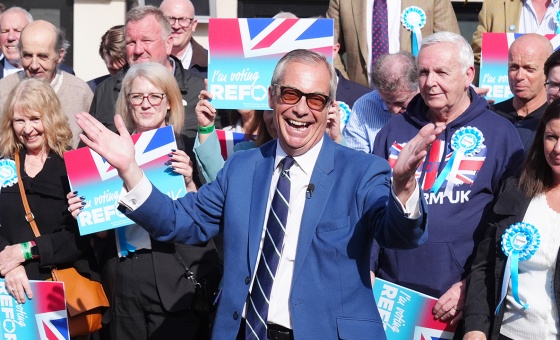This is the last article you can read this month
You can read more article this month
You can read more articles this month
Sorry your limit is up for this month
Reset on:
Please help support the Morning Star by subscribing here
FIFTY years ago, on November 10 1966, an industrial dispute began in Stockport which attracted national media coverage, saw mass picketing, international solidarity action and the eventual closure of the company.
The dispute centred on union-busting and the exploitation of women workers being used as “cheap labour.”
The Morning Star journalist Jim Arnison described the dispute as one of the “biggest strikes in the history of the trade union movement and involved the most basic freedom of all workers — the right to organise.”
Roberts Arundel was a textile machinery manufacturer situated in Chestergate, Stockport, just outside of the town centre.
Robert E Pomeranz, a US businessman who owned the Roberts company, based in Sanford, North Carolina, had bought the company. The British firm, Arundel’s, included a number of small British factories including sites in Stockport and Preston.
In the early 1960s the British owners were looking for investment and Pomeranz stepped in.
Pomeranz had a record of anti-unionism. The president of the North Carolina State AFL-CIO described Robert E Pomeranz and his companies as “the most anti-union outfit in this state.”
Pomeranz appointed a new British managing director John Cox, and after a period of calm he began imposing sweeping changes to working practices.
He imposed 51 redundancies, refusing to honour longstanding “last in, first out” arrangements, resulting in the workers imposing an overtime ban and a four-day week — forcing the company to compromise.
In October 1966 rumours spread that the Preston site was due to close and machinery would be transferred to Stockport.
On November 10 the company announced the closure of the Preston site and told the Stockport stewards they would be advertising for women to start work at the Chestergate site.
On November 17 adverts appeared in local newspapers inviting women to apply for jobs at Roberts Arundel.
The stewards insisted that an agreement should be reached setting out rates of pay for women workers and opposing them being used as “cheap labour.”
This was the model Pomeranz used in the US. He employed women workers at a third of the rate similar workers could earn in Detroit.
He boasted to the New York editor of the Financial Times: “I am the ‘great white father’ of the company.” He also referred to a good employee as “one who did as he was told.”
The company refused to negotiate and when new women workers started they took the issue to John Tocher, the Amalgamated Engineering Union (AEU) Manchester district secretary, who took the issue up with the Engineering Employers Federation (EEF).
The company goaded the AEU by setting on more women workers without any agreement.
On November 28 union members went on strike. The EEF intervened but on December 2 the company sacked the entire workforce by sending their cards in the post and advertised for non-union replacement workers.
The press portrayed the strike as “jobs for women” but Tocher made it clear it was not a strike about women workers — it was union-busting.
The AEU began a boycott campaign of Roberts Arundel goods. Union members across the country refused to handle goods and unionised companies that continued to deal with Roberts Arundel were blacked.
Picketing of the site began in earnest — with the intention of stopping scab workers entering the factory and stopping goods going in and coming out.
Attempts were made to negotiate an agreement, but each time the company found ways to avoid a settlement in order to establish a new workforce.
The Sun reported that the unions would not achieve any of their aims, as production was “normal.”
Pomeranz visited Britain and the company flew the Stars And Stripes above the building.
Negotiations led by full-time AEU executive council member for the north west Hugh Scanlon were held at the Ministry of Labour, questions were asked in Parliament by Stockport’s two MPs, prime minister Harold Wilson tried to intervene and, after manufacturers’ group the EEF tried to help settle the dispute, the company simply resigned from the federation.
On February 22 1967 a mass picket of the site began, led by rank-and-file activists.
Some 1,500 pickets surrounded the building. Hundreds of workers from the Shell refinery in Carrington led by AEU convener Bernard Panter bolstered engineering workers picketing the site. Then the mood turned ugly.
Bricks and missiles flew as pickets surrounded the factory and pushed back the police who were defending it.
The chief constable rang Tocher, threatening to read the 1716 Riot Act which gave the police the right to “shoot to kill” anyone who did not disperse within an hour of the Act being read.
Tocher arrived in Chestergate and restored order by beginning to address pickets at a nearby meeting.
Many scabs left the building proclaiming they would never go back again. The press described the events as a “riot” and a “battle.” Panter’s army headed back to Carrington promising to return and, if need be, take the factory apart brick by brick.
The company then agreed to meet the union but Pomeranz poured petrol on the flames by announcing that there was no harm in talking but the union “should find new jobs for its members.”
The AEU stepped up the pressure and 30,000 engineering workers in north-west England stopped work in support of the Stockport workers.
The AEU district committee also agreed to a sixpence per member per week levy.
Attempts were made to settle the dispute — but, as the Manchester Evening News reported, “Players tried to earn popularity by claiming they could bring an end to the dispute.”
When the shop stewards and AEU officials were warned that Pomeranz would close the factory, their response was that “this would be good riddance.”
One fact that was kept under wraps was that Tocher had an ace up his sleeve.
One of the “scabs” at the factory was a union supporter, Paul Casey, who fed information to Tocher on production levels, morale among the workforce, what the management was saying to the workforce and identifying US nationals working illegally and two individuals who had been tailing Tocher to and from his home, office and to meetings. Casey was eventually rumbled and left the company.
As Casey had reported, morale at the factory was at rock bottom — with scabs being forced to keep two or more machines running — and regular adverts in the press for skilled workers disproved that the company was operating as normal.
An effective international boycott by the International Metalworkers Federation and the blacking of Roberts Arundel work by engineering workers, dockers and others was also biting.
Stockport Trades Council began organising another mass picket and demonstration and the Lancashire and Cheshire Trades Council Federation was planning to call out one million north-west workers for October 1967.
On September 1, 40 north-west engineering companies and construction sites stopped work and a crowd of 3,000 gathered in Stockport — the police had banned demonstrations at Chestergate. Roberts Arundel gave its scab workforce a “day off.”
In September another twist occurred when right-wing AEU official John Boyd intervened and secured what he said was a “return-to-work agreement.”
Boyd was also candidate against Scanlon for the presidency of the AEU. The problem was that the company failed to sign it and the workforce opposed it, and Scanlon eventually won the presidency of the union.
Following a meeting in early December with minister of labour Ray Gunter and Scanlon, Pomeranz announced the total closure of the company after the union rejected Pomeranz’s “peace terms.”
Scanlon in sadness told the press that how anyone could “pretend loyalty even to blacklegs, and then close a factory, and presumably leave the country, leaving behind all the misery and injuries is beyond belief.”
There were no victory celebrations. In April 1970 the company filed for bankruptcy. A few workers continued to picket what was an empty factory. But it was all over.
Pomeranz once said the “most important thing is the company’s profits.”
His attempts to bust the AEU didn’t work and it cost him a cool one million pounds — over £16m today.
The full story of the Roberts Arundel dispute, The One Million Pound Strike, was written by Jim Arnison and published in 1970.
- Tony Burke is assistant general secretary of Unite. The AEU and its successor unions are now part of Unite.









